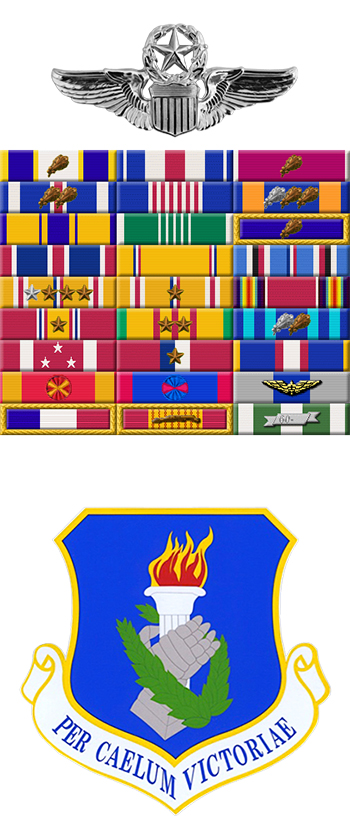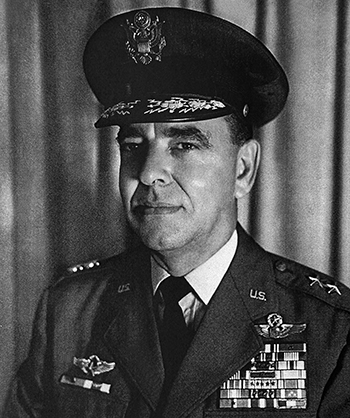
|
Robert R. "Dick" Rowland |
 |
|||
| Rank, Service | ||||
Major General O-8, U.S. Air Force |
||||
| Veteran of: | ||||
|
||||
| Tribute: | ||||
Dick Rowland was born on October 8, 1917, in Lodi, Ohio. After attending Ohio State University and the University of Maryland he enlisted in the Aviation Cadet Program of the U.S. Army Air Corps on March 1, 1938. He attended Primary Flying School at Randolph Field, Texas, and Advanced Flying School at Kelly Field, Texas, where he was commissioned a 2nd Lieutenant and awarded his pilot wings on February 2, 1939. His first assignment was as a P-40 Warhawk pilot with the 94th Pursuit Squadron of the 1st Pursuit Group at Selfridge Field, Michigan, from February to September 1939, followed by service as a P-40 pilot with the 16th Pursuit Squadron at Albrook Field, Panama Canal Zone, from September 1939 to September 1941. Lt Rowland served as a Flight Instructor and Squadron Operations Officer at the Advanced Flying School at Craig Field, Alabama, from September to December 1941, and then as Director of Advanced Training and Director of Fighter Training at Tuskegee Army Flying School in Tuskegee, Alabama, from December 1941 to February 1943. Major Rowland's next assignment was as a P-47 Thunderbolt pilot and Executive Officer of the 348th Fighter Group at Providence, Rhode Island, from February to November 1943, followed by service as a P-47 and then P-51 Mustang pilot and Commander of the 348th Fighter Group in New Guinea, Wakde, Noemfoor, in the Philippines, and then on Ie Shima from November 1943 to June 1945. During this time he was promoted to Lieutenant Colonel in January 1944 and to Colonel in May 1944, and he was credited with the destruction of 8 enemy aircraft in aerial combat, all while flying the P-47, between October 1943 and February 1944. Col Rowland served as Chief of the Tactical Air Force Branch with Headquarters Continental Air Forces at Bolling Field, Washington, D.C., from June 1945 to July 1946, and then as Chief of the Operations Division with Headquarters Strategic Air Command from July 1946 to September 1947. He attended Air Command and Staff School at Maxwell AFB, Alabama, from September 1947 to July 1948, and then remained at Air Command and Staff School as an instructor, branch chief, and then division chief from July 1948 to July 1951. He next attended Air War College at Maxwell AFB from July 1951 to June 1952, followed by service with the Central Intelligence Agency in Washington, D.C., from June 1952 to April 1953. Col Rowland served as Commander of the 21st Fighter Bomber Wing at George AFB, California, and then at Chambley AB, France, from April 1953 to July 1956, and then as Deputy Chief of Staff for Operations with Headquarters 12th Air Force at Ramstein AB, West Germany, from July 1956 to December 1957. His next assignment was as Assistant Deputy Chief of Staff for Operations with Headquarters U.S. Air Forces in Europe at Ramstein AB from December 1957 to July 1958, followed by service as Deputy Director of Plans and Policy, Directorate of Plans, Deputy Chief of Staff for Plans and Programs at Headquarters U.S. Air Force in the Pentagon from July 1958 to July 1960. Col Rowland next served as Secretary of the Air Staff with Headquarters U.S. Air Force at the Pentagon from August 1960 to December 1962, and during this time he was promoted to Brigadier General in March 1961. He served as Chief of the Air Force Section with the Military Assistance Advisory Group in Saigon, South Vietnam, from December 1962 to August 1964, and then as Chief of the Air Force Advisory Group with U.S. Military Assistance Command Vietnam in Saigon from August 1964 to July 1965. During this time he was promoted to Major General in April 1965. His next assignment was as Chief of Staff with Headquarters Pacific Air Forces at Hickam AFB, Hawaii, from July 1965 to April 1967, followed by service as Chief of Staff with Headquarters Tactical Air Command at Langley AFB, Virginia, from April 1967 until his retirement from the Air Force on June 1, 1968. Major General Rowland flew 203 combat missions during World War II, and several more while stationed in South Vietnam during the Vietnam War. Dick Rowland Flew West on January 26, 2003, and was buried at Princess Anne Memorial Park in Virginia Beach, Virginia. |
||||
|
||||

